Taiwan and Beijing 2014
CLICK ON PHOTOS TO ENLARGE
Taiwan and Beijing 2014
For many years my company in England has sold excellent electronic products made in Taiwan, and a few years ago we became sole agents for them. After my 2013 visit to South Korea and Beijing, which I greatly enjoyed, I felt that I had unfinished business in the Beijing area, in the form of two car museums that I particularly wanted to see, and decided to combine a trip to Taiwan with another 72-hour visa-free stay in Beijing.
Taiwan, formerly known as Formosa, actually exists in a state of political limbo. Some time ago the much-respected British travel journalist and TV presenter Simon Reeve included Taiwan in a list of “Countries That do not Exist”. By that he meant countries that are not recognised as independent states by most other nations, especially the more prominent ones. In the case of Taiwan this applies to Britain, most other European countries, the USA and Russia.
In the 1950s the Chinese Nationalists, under Chiang Kai-shek, left the Communist controlled Chinese mainland for the island of Formosa to set up a capitalist economy which developed into the modern Taiwan. The country has thrived as an advanced industrial nation, supplying good quality products at competitive prices to the rest of the world, and the political status quo is currently widely accepted, even by mainland China.
Following my previous experience I decided to fly with Air China and have the visa-free stay in Beijing on the return journey. After travelling for more hours than I care to think about I arrived at the Novotel at Taipei airport at 2am on the last shuttle bus of the night.
At 11am the next morning I collected my rental car from the High Speed Rail Station a few miles away. The choice of rental companies in Taiwan is limited, especially if you are over 70, and I had had protracted negotiations in advance over my International Driving Permit, In most countries where there is a requirement for an IDP nobody actually takes much notice of it, but in Taiwan it appears that the rental company has to send a copy in advance to the local government motor vehicle office for approval.
In the rental office we were communicating partly via a laptop with Google Translate, and in a country where most signs would be in Chinese, with few people speaking English, I knew that some form of electronic navigational aid would be essential. The people in front of me at the rental desk were given a small TomTom-like satnav, so I asked for one. The man said “No good, all Chinese”. Not long before leaving home I had acquired a Nokia smartphone with GPS and had downloaded maps of Taiwan and Beijing into it. According to the instructions it would then work without needing a fantastically expensive data connection. Young people find these things easy to set up, expect them to work and are surprised if they don’t. In my age group you find it hard to set them up, don’t expect them work, and are amazed if they do. I could only hope.
For the first day I had set a modest target of driving about 30 miles to a place called Fantasy World, a theme park which was supposed to have Taiwan’s only classic car museum, and then to my hotel in a town called Jhubei, Chupei, or Zhubei. Road directions signs and street names are almost always in Chinese and English, but the variation in English spelling does not make things any easier.
It was a fast run in my Mitsubishi Lancer down the freeway to a place called Chutung (or Jhudong), where I expected to find Fantasy World. A short time after entering the town I picked up a Chinese/English brown tourist sign to ‘Fantasy World of Successful Group’. These signs continued for miles through the town and on to twisty roads out into the countryside before I eventually lost them. For about half an hour I searched around before trying to ask some men at a car workshop, but although they were very keen to help we were defeated by the language barrier. I suddenly had the brilliant idea of going back and photographing the last sign and showing it to them. They practically jumped with joy at realising what I was looking for, but then explained that it was closed five years ago. So it was ultimately the ‘Fantasy World of Unsuccessful Group’.
My hotel was close to the centre of Jhubei, but was not likely to be signposted, so I decided to try the GPS in the phone. To my astonishment it worked! The map could be expanded to show the names of even the smallest streets, and this meant that within seconds I could find out where I was anywhere in Taiwan providing that the satellites were available. It did not take long to find the hotel but without the phone it would have been a nightmare and there is no doubt that I would have had to change my plans substantially.
 After getting sorted I went for a walk round the town. The most striking thing was the astonishing number of motor scooters, which were parked all along the roadsides, on the pavements, as much as there were any, and on the special strip of road reserved for scooters. This meant that it was impossible to walk along the streets without mixing with the traffic, but that seemed to be the accepted situation. Near the hotel was a large dedicated scooter park with a little scooter-sized barrier at the entrance, and on the way to the hotel I had caused some confusion by attempting to drive through a tunnel under the railway that was actually for scooters only.
After getting sorted I went for a walk round the town. The most striking thing was the astonishing number of motor scooters, which were parked all along the roadsides, on the pavements, as much as there were any, and on the special strip of road reserved for scooters. This meant that it was impossible to walk along the streets without mixing with the traffic, but that seemed to be the accepted situation. Near the hotel was a large dedicated scooter park with a little scooter-sized barrier at the entrance, and on the way to the hotel I had caused some confusion by attempting to drive through a tunnel under the railway that was actually for scooters only.
Jhubei is only about 6 miles from the west coast, which is on the Formosa Strait, and the next morning I decided to have a look at it before driving south to cross over the mountains. The nearest point to Jhubei is the large fishing port of Hsinchu. At the harbour entrance is a promontory described on my map as a ‘Wind Activity Park’, and when I arrived on the Sunday morning it was being well-used by families with kites. Alongside was it a massive indoor and outdoor food market with a mind-boggling range of sea food including many things that I did not recognise, but I am no expert.
the harbour entrance is a promontory described on my map as a ‘Wind Activity Park’, and when I arrived on the Sunday morning it was being well-used by families with kites. Alongside was it a massive indoor and outdoor food market with a mind-boggling range of sea food including many things that I did not recognise, but I am no expert.
From Hsinchu I drove a few miles along the coast on a fast road before turning inland through Chunan and Toufen to the mountains. This was a complicated urban route and without my GPS phone I could not have done it. After 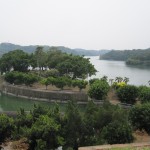 passing a scenic reservoir I joined route 3 which was to take me a good part of the way to my night stop in Puli (or Pulli). Shortly before a town called Sanwan was a tourist attraction which turned out to be a Buddhist monastery with limited public access. There were lots of people just looking, some praying, and as I wandered around a few of the monks nodded and smiled benevolently but did not attempt to break through the language barrier.
passing a scenic reservoir I joined route 3 which was to take me a good part of the way to my night stop in Puli (or Pulli). Shortly before a town called Sanwan was a tourist attraction which turned out to be a Buddhist monastery with limited public access. There were lots of people just looking, some praying, and as I wandered around a few of the monks nodded and smiled benevolently but did not attempt to break through the language barrier.
For about the next 50 miles the road was scenic but busy, running alongside the mountains before eventually losing most of the traffic and starting to climb in the direction of Pulli. According to the Lonely Planet guide Pulli was a resort town with expensive hotels, and I expected to find somewhere like Harrogate or Cheltenham. By the time I got there it was dusk, and the main street was a scene of frantic activity, ablaze with neon signs and all the characteristics of a Chinese town. Driving through such a street is an all consuming experience, demanding a high level of concentration to deal with chaotic events on the road against a background of multiple distractions. Nothing like Harrogate at all.
Once through the main street I managed to find somewhere to park and take stock of the situation. The jet lag was still coming into play, and I did not feel like wandering about searching for a hotel. I looked around and saw a sign saying HOTEL high up on a building not far away. Without too much trouble I managed to find it, and it turned out to be quite a classy looking place called the Yoou Shan Grand Hotel. When I entered the vast and impressive reception area I realised that in every way, including price, it was outside my normal range. I also realised that, scruffily attired as I was (and always am), I was outside the normal range of its clientele.
As I booked in I put on a brave face and the staff did likewise. My room was, as expected, near perfect, the only striking thing being the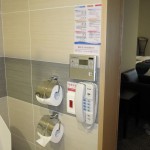 high-tech Japanese lavatory, the first I have seen outside Japan. It was a more recent development of the ones I saw there, having a remote control unit that could be detached from the wall and used anywhere in the room. This meant that it was possible, amongst many other things, to lift the seat cover, the seat, and flush the bowl without getting out of bed. Very useful. Comprehensive instructions in Chinese were on the wall alongside the toilet, with graphic pictures showing the multitude of available functions, and next to them a telephone. This was presumably to summon help if the lavatory went out of control while you were sitting on it.
high-tech Japanese lavatory, the first I have seen outside Japan. It was a more recent development of the ones I saw there, having a remote control unit that could be detached from the wall and used anywhere in the room. This meant that it was possible, amongst many other things, to lift the seat cover, the seat, and flush the bowl without getting out of bed. Very useful. Comprehensive instructions in Chinese were on the wall alongside the toilet, with graphic pictures showing the multitude of available functions, and next to them a telephone. This was presumably to summon help if the lavatory went out of control while you were sitting on it.
To offset the vast cost of the accommodation I went out for a cheap meal, and as I walked across the reception area someone ran in front of me to open the door. From this point on the staff fawned over me to such an extent that I decided that they thought either that I was a hotel inspector for a Western travel company or that I was a prospective purchaser of the establishment.
The next morning I was the only guest in the enormous restaurant and as I approached the breakfast buffet a young lady followed to help me work the coffee machine, which was about 70 yards away. Just as I had eaten as much as I wanted a waiter came over and said the chef had prepared something special for me. This turned out to be a ‘Western’ breakfast. ‘Western’ breakfasts in the Far East seem to be prepared by people who have never been to the West, but have read about it, and this one was no exception. However, to avoid causing offence I did my best to do justice to it and expressed my appreciation.
The plan for the day was to drive across to the east coast via one of the few routes over the mountains. Looking at the map this entailed 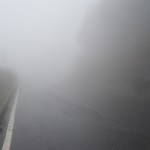 a drive of 90 miles of continuous mountain road, rising to a height of 3,275m (10,600 ft) at Wuling in the middle. After a place called Wushe, about 15 miles from Puli, I ran into fog (actually low cloud, I suppose), and that went on for about two hours. The road was never straight for more than 150 yards, and varied in width constantly from 40 ft down to single track, with a sheer drop on my side, though usually protected by a substantial barrier. In many places the posted speed limit was 15 or 18mph, but that was too fast for the conditions. The traffic coming the other way was not heavy, but it consisted mostly of lorries and buses, and for stressful driving I can say that it was equalled only by driving into Moscow, which was a very different experience. After an hour it was becoming dangerously hypnotic, and I stopped for a while to rest. A thing that annoyed me was that I knew I must be missing fantastic scenery.
a drive of 90 miles of continuous mountain road, rising to a height of 3,275m (10,600 ft) at Wuling in the middle. After a place called Wushe, about 15 miles from Puli, I ran into fog (actually low cloud, I suppose), and that went on for about two hours. The road was never straight for more than 150 yards, and varied in width constantly from 40 ft down to single track, with a sheer drop on my side, though usually protected by a substantial barrier. In many places the posted speed limit was 15 or 18mph, but that was too fast for the conditions. The traffic coming the other way was not heavy, but it consisted mostly of lorries and buses, and for stressful driving I can say that it was equalled only by driving into Moscow, which was a very different experience. After an hour it was becoming dangerously hypnotic, and I stopped for a while to rest. A thing that annoyed me was that I knew I must be missing fantastic scenery.
Once over the summit at Wuling, which is the highest made-up road in East Asia, visibility improved and the scenery appeared, in the form of tree-covered mountains in all directions. This altitude in the European Alps would be far above the tree line, exposing bleak, bare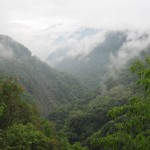 or snow-covered rock, but personally I prefer the lush, green vegetation of Taiwan.
or snow-covered rock, but personally I prefer the lush, green vegetation of Taiwan.
The road was now in Taroko National Park, famed for its beauty, and the drive for the next 50 miles was a motoring enthusiast’s dream, with seemingly endless hairpin bends, tunnels and rock arches. It.finally entered Taroko Gorge, known as one of ‘The Seven Wonders in Asia’. Unfortunately I did not have time to explore the many walking and cycling trails, for which a week would not be adequate, let alone a day.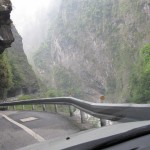 From Puli it had taken all day to drive the 90 miles to the east coast on the Pacific Ocean, but despite the fog I think it was the best day’s driving I have ever had. The road actually comes to the coast at a small place called Hsincheng, but I decided to drive about another 12 miles south to Hualien, a larger town where it would be easier to find accommodation. In the event it proved to be easy to find a decent hotel at less than half the cost of the one in Puli. By the time I had a walk around and a cheap unadventurous meal in a convenience store I was too tired to do anything but go to bed.
From Puli it had taken all day to drive the 90 miles to the east coast on the Pacific Ocean, but despite the fog I think it was the best day’s driving I have ever had. The road actually comes to the coast at a small place called Hsincheng, but I decided to drive about another 12 miles south to Hualien, a larger town where it would be easier to find accommodation. In the event it proved to be easy to find a decent hotel at less than half the cost of the one in Puli. By the time I had a walk around and a cheap unadventurous meal in a convenience store I was too tired to do anything but go to bed.
Before driving north the next morning I went into Hualien, and by chance discovered a marvellous street market. The amazing thing about it was the incredible number of elderly people, men and women, turning up on motor scooters. Some of them must have been 90, and if they were having difficulty in balancing they didn’t give up, but just had an extra pair of wheels fitted at the back, alongside the normal rear wheel. One or two had dogs standing on the footboard, and it was clear that for these people their scooters had been an integral part of their lives for many years.
the back, alongside the normal rear wheel. One or two had dogs standing on the footboard, and it was clear that for these people their scooters had been an integral part of their lives for many years.
From Hualien I drove northwards along the coast to the strangely Anglo-Saxon sounding Chisingtan Beach. It was hard to believe that the last time I had seen the Pacific was in Valporaiso in Chile, which I subsequently discovered was 11,500 miles straight across the ocean, further than the shortest distance between England and Australia.
For about the next 60 miles the road, as Highway 9, followed the edge of the mountain range, a spectacular route wending its way along the cliff face with steep climbs and tunnels through the rock. Looking across the sea to the right I was reminded of the much acclaimed 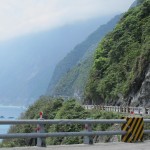 Pacific Coast Highway in California, about 7000 miles away with only water in between. I have driven the best parts of the PCH several times, but never been as impressed as I expected to be, and to my mind it cannot hold a candle to Taiwan Highway 9. The only problem with Highway 9 is slow-moving trucks, although their drivers are as helpful as they can be in creating overtaking opportunities. It is said that the coast road running about 150 miles
Pacific Coast Highway in California, about 7000 miles away with only water in between. I have driven the best parts of the PCH several times, but never been as impressed as I expected to be, and to my mind it cannot hold a candle to Taiwan Highway 9. The only problem with Highway 9 is slow-moving trucks, although their drivers are as helpful as they can be in creating overtaking opportunities. It is said that the coast road running about 150 miles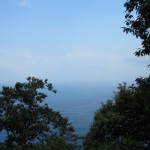 south from Hualien is even more scenic than the stretch I drove.
south from Hualien is even more scenic than the stretch I drove.
Some distance after a town called Suao I turned inland, between rice fields, to Lotung (or Lodong or Luodong) where I found a hotel for the night. Most Taiwanese towns have a night market, and the people in the hotel told me how to find the one in Lotung, but I was actually a bit disappointed with it. I don’t know what I was expecting, but it was just a day market held at night!
During my visit to the Great Wall of China near Beijing the previous year a group of young office workers from Taipei had invited me to join them in sharing a minibus, an arrangement that worked very well for me. We kept in touch and agreed to meet again on my planned visit to Taipei in 2014. They suggested that I call into their office on the afternoon following my stay in Lotung, 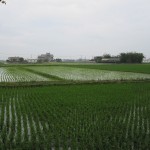 which meant driving across the mountains on an old mountain pass or taking the shorter, faster, freeway including a 12.9km tunnel. Most sensible people would have taken the latter route, so I chose the former. It was
which meant driving across the mountains on an old mountain pass or taking the shorter, faster, freeway including a 12.9km tunnel. Most sensible people would have taken the latter route, so I chose the former. It was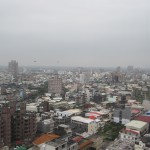 yet another brilliant drive with a town called Pinglin half way. Pinglin has the character of an American western town, and at one time must have been quite isolated, but now has a freeway junction close to it.
yet another brilliant drive with a town called Pinglin half way. Pinglin has the character of an American western town, and at one time must have been quite isolated, but now has a freeway junction close to it.
The following morning I had an appointment with my business associates in Chungyang Road, Taipei, so before leaving home I had booked a hotel about 200 yards from their offices in the same road. This meant driving about eight miles across the city, which would have been a very daunting prospect without my GPS phone, but in the event proved to be fairly easy. Taipei was a far cleaner and 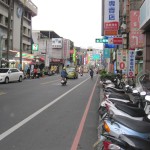 pleasanter place than I expected, the traffic in the middle of the afternoon being quite civilised. With the car safely tucked away in the hotel’s underground car park I set off via the metro for my friends’ office near the city centre.
pleasanter place than I expected, the traffic in the middle of the afternoon being quite civilised. With the car safely tucked away in the hotel’s underground car park I set off via the metro for my friends’ office near the city centre.
For years I had imagined that Taipei was like a vast slum, full of two- or three-storey crowded sweatshops in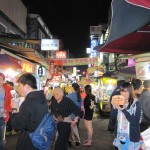 narrow alleys, with people slaving away in poor conditions. I did not see anything like that, and my friends turned out to be working on the sixth floor of a large modern air-conditioned office block that would have been at home in Canary Wharf in London. They actually work for a sports marketing company that organises baseball and basketball events mainly in association with American teams, hence the fact that they all speak good English.
narrow alleys, with people slaving away in poor conditions. I did not see anything like that, and my friends turned out to be working on the sixth floor of a large modern air-conditioned office block that would have been at home in Canary Wharf in London. They actually work for a sports marketing company that organises baseball and basketball events mainly in association with American teams, hence the fact that they all speak good English.
When I left them the rush hour was just getting under way and the scooters were out in force. At the traffic lights they ride to a dedicated scooter space at the front of the queue, forming a dense block, and when the lights change the description ‘Traffic Lights Grand Prix’ is a gross understatement. The use of scooters on this scale in a developed country is probably 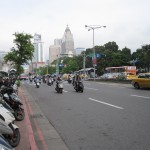 unique to Taiwan, but it must greatly reduce the pressure on public transport. At 7.00pm in the subway on the way to back to my hotel I was able to get a seat immediately, which would not have been possible at that time in most capital cities.
unique to Taiwan, but it must greatly reduce the pressure on public transport. At 7.00pm in the subway on the way to back to my hotel I was able to get a seat immediately, which would not have been possible at that time in most capital cities.
Before going to the subway I wandered round the central area, which is dominated by Taipei 101, the world’s tallest building from 2004 until 2010, and still boasts of having the fastest lift, at 1010m per minute (approx. 37mph) going up. The top was in the clouds. Another spectacular building with classical Chinese architecture is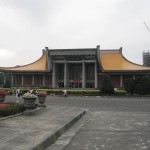 the Sun Yat-Sen Memorial Hall, containing a large seated figure of Dr. Sun Yat-Sen, the founding father of modern China. Unfortunately I did not get time to see the downtown area of the city.
the Sun Yat-Sen Memorial Hall, containing a large seated figure of Dr. Sun Yat-Sen, the founding father of modern China. Unfortunately I did not get time to see the downtown area of the city.
At 10.00am the next morning I drove along Chungyang Road to my business associates who were also in an impressive modern building, far better than the one I work in in England. Following a discussion I was shown their state-of- the-art factory and then taken out to lunch at a nearby restaurant. In the afternoon a lady named Annie took me by taxi to Taipei 101 where we experienced the breathtaking lift and view from the 89th floor. The building actually has 101 floors, hence the name. but the highest part open to the public is a small outside area on the 90th floor with a limited view but unlimited wind.
My flight to Beijing was the next day, so I had booked a hotel in a small town called Taoyuan not far from the airport. At least, I thought it 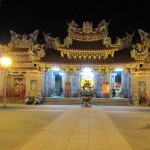 was a small town, but all Taiwanese towns are larger than you expect and Taoyuan was no exception. It seemed to be quite an old town,
was a small town, but all Taiwanese towns are larger than you expect and Taoyuan was no exception. It seemed to be quite an old town,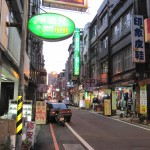 and the hotel was in a central area of narrow one-way streets around an ancient temple, making it quite hard to find even with the magic phone. The area was very lively in the evening, with a vast range of shops and eating places, including a couple of big department stores.
and the hotel was in a central area of narrow one-way streets around an ancient temple, making it quite hard to find even with the magic phone. The area was very lively in the evening, with a vast range of shops and eating places, including a couple of big department stores.
At the Car Plus rental office in the HSR station the next morning everything went smoothly when I took the car in. Renting cars in foreign countries is fraught with potential problems at the best of times, and when communication is almost impossible you are dependent upon the honesty of the people you are dealing with. In Taiwan I had not met anyone whose integrity I doubted, and I had no reservations about the Car Plus staff.
The A330-300 to Beijing was full, and as far as I could see I was the only Westerner on the flight. At one point a stewardess came down the aisle carrying a single blank entry card for China and gave it to me. At Beijing airport there was no problem in arranging the 72-hour visa-free stay or with getting the Airport Express to Dongzhimen subway station. I had booked a hotel for three nights near the station, to minimize the need to hump my bags around the city. The JI Hotel was about 400 yards from the station and easier to find than I expected, but had no English-speaking people at the reception desk. Somehow we muddled through without Google translate.
The plan for the next day was to visit a privately owned classic car museum in a town called Huairou, about 20 miles north of Beijing and it would also be an opportunity to look round a Chinese town other than the enormous capital city. On my previous visit I went through Huairou on the way to the Great Wall at Mutianyu, but did not have time to get to the museum, although at least I remembered how to get to the town.
and it would also be an opportunity to look round a Chinese town other than the enormous capital city. On my previous visit I went through Huairou on the way to the Great Wall at Mutianyu, but did not have time to get to the museum, although at least I remembered how to get to the town.
The usual way for tourists is to take the so-called fast bus from the Dongzhimen Transport Hub, just around the corner from my hotel. The bus was easy to find, with a bright neon sign on the front showing 916 followed by a Chinese character meaning FAST (I had read about this on the internet). The queue was also easy to find, being about 100 yards long, but it seemed that the buses were running on demand rather than to a time-table, and as one drove off another one appeared, so the wait was only about 15 minutes. The fare for the 20-mile journey was 12 yuan (£1.20).
Most of the way to Huairou is motorway, and I knew from my previous experience of this route that it would probably be slow going on a Saturday morning. One cause of the hold-up was the toll station with about 12 booths a few miles north of Beijing, but it seemed that there had been an incident of some sort as well, and the bus crawled at a snail’s pace for a long time. For a country in which a relatively small proportion of people own cars the volume of traffic was amazing, but as with everything else in China, a small proportion of the population is still a very large number of people. The sun was blazing through the window next me and although there was supposed to be air-conditioning it did not seem to be working very well, to the point where I was seriously worried about getting heat stroke or something. Most of the other passengers were younger and didn’t appear to be very bothered, but I was relieved when the bus finally got moving properly.
The terminus was Huairou Bus Station, and as expected I was hassled by taxi and minibus drivers wanting to take me the Great Wall. They could not imagine that a Westerner would want to do anything else, and were perplexed when I walked across the road to the toilets and then went off in search of a cup of coffee.
I found a small café and went in and asked for coffee. Apart from a couple of times in the American South (where you have to ask for ‘car-fee’) I think this is only time I have not been understood, and here I was very not understood. The people looked at me as if I had just dropped in from another planet, possibly the first Westerner they had seen close up. I repeated ‘Coffee’ a few times, and the lady in charge then suddenly produced two small sachets of Nescafe. I said “Yes!, Yes!”, and they all started to laugh. She held up a small glass, and I said “Yes”, so in a short time she returned with it containing a strong solution of Nescafe in hot water. Apparently this was very, very, funny, and all the time I sat drinking it (it was pretty horrible) they were chuckling away looking in my direction. When I asked to pay they refused to accept anything, seemingly because the entertainment value far exceeded the cost of a sachet of Nescafe and some hot water. This was entirely lost on me, but I left feeling that I had made a small contribution to East-West relations.
A short distance along the road I found a taxi waiting for a fare, and showed the driver the address of the car museum in Chinese which I had printed off their website. He knew immediately where it was and took me there by the most direct route, which I had memorised from a map. The museum was in a warehouse-type building, and contained a collection of mostly Chinese and Russian vehicles collected by 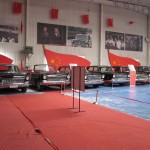 Mr.Luo Wen You since the 1980s. There were some very strange cars about which I would have liked more information, but no one spoke English and all the notices were in Chinese. Towards the end of my visit a man of uncertain age appeared, and a lady who spoke a little bit of English introduced him to me as Mr.Luo Wen You. He spoke no English, but insisted on taking me back into the collection and photographing me (using my camera) alongside some of the prize exhibits. A large group of people in their late teens were visiting the museum and one or two who spoke good English were then summoned to act as interpreters.
Mr.Luo Wen You since the 1980s. There were some very strange cars about which I would have liked more information, but no one spoke English and all the notices were in Chinese. Towards the end of my visit a man of uncertain age appeared, and a lady who spoke a little bit of English introduced him to me as Mr.Luo Wen You. He spoke no English, but insisted on taking me back into the collection and photographing me (using my camera) alongside some of the prize exhibits. A large group of people in their late teens were visiting the museum and one or two who spoke good English were then summoned to act as interpreters.
My intention had been to ask the museum people to phone for a taxi to take me back to the bus station, but before I had a chance it was explained that it was not convenient to get a taxi so Mr. Luo Wen You would take me to a bus stop in his car. After being photographed with me in the entrance to the building he took me in his well worn Skoda to a bus stop at the side of a dusty main road in the somewhere in the suburbs.
A few other people were waiting for the bus, and I somehow realised that this was the route of the 916FAST to Beijing. That was a problem, because before going back to Beijing I wanted to go to the toilet, have something to eat, and have a look round Huairou. Also, I was thinking of going back on the train, just for the experience.
By pointing to Huairou bus station, labelled in Chinese on my map, I was eventually able to persuade everyone that that was where I wanted to go, although they could not understand why a foreigner could possibly want to do anything other than get back to Beijing as soon as possible. A bus came that was not the 916FAST and everyone told me to get on it, so I did, assuming that it was going to the bus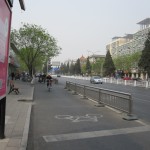 station. However, a couple of miles along the road it stopped at a bus stop where another bus was standing. All the people round me shouted “GET OFF, GET OFF” and pointed to the other bus. Not understanding what was happening I got off, and then realised that the other bus was the 916FAST to Beijing! It pulled away before I had time to get on it anyway, so I was back to the roadside and the whole thing started all over again. A different lot of people were at this bus stop and I was just trying to convince them that I wanted to go the bus station when a taxi driver standing nearby offered to take me there for 50 yuan (£5). I jumped at the chance, and within a couple of minutes we stopped at the bus station. When I gave the driver a 50 yuan note he gave me 35 yuan back, so the fare was actually 15 yuan, a misunderstanding due to the subtle difference between 15 and 50 when spoken with a Chinese accent.
station. However, a couple of miles along the road it stopped at a bus stop where another bus was standing. All the people round me shouted “GET OFF, GET OFF” and pointed to the other bus. Not understanding what was happening I got off, and then realised that the other bus was the 916FAST to Beijing! It pulled away before I had time to get on it anyway, so I was back to the roadside and the whole thing started all over again. A different lot of people were at this bus stop and I was just trying to convince them that I wanted to go the bus station when a taxi driver standing nearby offered to take me there for 50 yuan (£5). I jumped at the chance, and within a couple of minutes we stopped at the bus station. When I gave the driver a 50 yuan note he gave me 35 yuan back, so the fare was actually 15 yuan, a misunderstanding due to the subtle difference between 15 and 50 when spoken with a Chinese accent.
A quick visit to the toilet and then a walk into the town to find something to eat. By now I was desperately hungry and seized upon the first opportunity to get some food, which was in a burger restaurant. Needless to say, no one spoke English, but there were pictures of meals all over the walls, and I pointed to one consisting of a burger, chips and ‘soda’. This seemed very straightforward to me, but it wasn’t to the staff, who responded with various questions in Chinese. I just pointed again, said “That, please”, and indicated which drink I wanted from the cabinet before sitting down. Eventually an enormous burger and great quantity of chips appeared, and I realised that they had answered one of their questions by deciding that I wanted to “go large”.
By now it was apparent that Huairou was a ‘new town’ similar in character to Stevenage or Crawley, and was about as interesting. It was nothing like the more traditional Chinese towns that I had seen in Taiwan, and as time was running out anyway I made my way to the 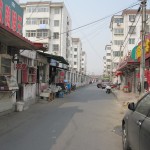 railway station. This was deserted apart from the man in the ticket office, who clearly resented being disturbed in the middle of the afternoon, especially by a foreigner. When I asked for a ticket to Beijing he wanted to see my passport. No one had asked for that on the bus, so presumably people plotting to overthrow the Chinese government only travel by train.
railway station. This was deserted apart from the man in the ticket office, who clearly resented being disturbed in the middle of the afternoon, especially by a foreigner. When I asked for a ticket to Beijing he wanted to see my passport. No one had asked for that on the bus, so presumably people plotting to overthrow the Chinese government only travel by train.
He told me the fare, which was slightly more expensive than the bus, and mentioned that the next train was not for two hours. On hearing that I had to drop the idea, because there were buses every 10 minutes or so, and I needed to be back at my hotel to meet my Chinese friend Herbert at 7.00pm.
Herbert was my guide for the electric scooter tour on my previous visit to Beijing and we had kept in touch by email. At one time he worked in HR for a hotel group and then became a full-time tour guide. He has his own website and I was very impressed with the professional manner in which he does things, acting almost like a one-man travel agent. We went for a meal to a “roasted duck restaurant” near my hotel and it was interesting to talk to him about life in Beijing amongst other things.
Originally I had hoped to rent an electric scooter the next day to go to yet another car museum in the south east of the city near the fourth ring road, but it was at least 10 miles each way, and bearing in mind that I would probably get lost the rental firm said there was a risk that the battery would not last out the whole journey. It would obviously be a big problem to be stranded somewhere in the suburbs, so that was another good idea that I had to drop.
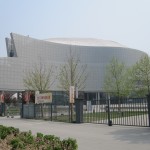 The only sensible alternative was the subway, which meant 18 stops with several changes but it is very cheap
The only sensible alternative was the subway, which meant 18 stops with several changes but it is very cheap and quite easy to use, although I had to stand a lot of the time. The Beijing Auto Museum is government owned, with an impressive building only a few years old. It was vaguely inspired by the Mercedes Benz Museum in Stuttgart, with several floors, and the whole idea of a communist government investing so lavishly in a monument to the motor car does seem rather odd, but it has a strong educational content with lots of entertainment for families rather than car enthusiasts. Judging by the number of people there it is very successful.
and quite easy to use, although I had to stand a lot of the time. The Beijing Auto Museum is government owned, with an impressive building only a few years old. It was vaguely inspired by the Mercedes Benz Museum in Stuttgart, with several floors, and the whole idea of a communist government investing so lavishly in a monument to the motor car does seem rather odd, but it has a strong educational content with lots of entertainment for families rather than car enthusiasts. Judging by the number of people there it is very successful.
Afterwards I made my way back to Tiananmen Square by underground, and was surprised to find on the approach to the square a security checkpoint in which my back pack was x-rayed. This was apparently because it was close to the 25th anniversary of the incident in which a large number of students were shot during an anti-government demonstration. From the world’s 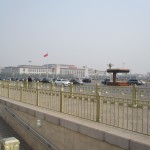 largest public square I followed a lot of other people over a bridge and through an opening in the Gate of Heavenly Peace, leading towards the Forbidden City. It was too late to go into the Forbidden City, so I cut across to the main shopping area which was still thronging with people including many foreign tourists.
largest public square I followed a lot of other people over a bridge and through an opening in the Gate of Heavenly Peace, leading towards the Forbidden City. It was too late to go into the Forbidden City, so I cut across to the main shopping area which was still thronging with people including many foreign tourists.
Within a short time I was accosted by a charming young lady who spoke excellent English, and she asked me where I was from. I said “England”, and she replied “I am a student, I am learning English. Can I walk along with you and chat for a while?” Fortunately, I am a man of the world and have read all the right books, so I knew what this was about, and it is not what you think. It is a common scam in that area. They walk with you for a while, then suggest that you go into a place for a cup of tea. You are taken into a traditional Chinese tea house and involved in an elaborate, long drawn out tea-making ceremony. When you come to leave at the end they present you with a bill for £250. If you refuse to pay a heavyweight man appears and says that is the charge for the tea-making ceremony, so pay up or else! I declined to get involved, and as I walked away she said, in a very hurt voice, ”Oh, why not?”.
Before getting the subway back to Dongzhimen I wanted to have a look at some hutongs, the lanes that made up most of Beijing in the old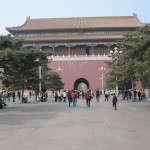 days. Large areas of them have been replaced by modern development, but a fair number are left in some places, and I came to some not far north of the shopping centre. Basically they are narrow streets lined with mostly single-storey buildings in which people live and in many cases also work. I set off along one lane with the intention of walking through to the next main street, which looked quite a long way, but after about 300 yards I realised that this was a much more run down area than the ones I had seen on my previous visit. It could only be described as a slum, with people living in very poor conditions, and although no one took any notice of me I decided that it might not be wise to proceed any further. In the USA or South America I would have been mugged before getting that far, but in Beijing it is generally considered to be safe to wander about.
days. Large areas of them have been replaced by modern development, but a fair number are left in some places, and I came to some not far north of the shopping centre. Basically they are narrow streets lined with mostly single-storey buildings in which people live and in many cases also work. I set off along one lane with the intention of walking through to the next main street, which looked quite a long way, but after about 300 yards I realised that this was a much more run down area than the ones I had seen on my previous visit. It could only be described as a slum, with people living in very poor conditions, and although no one took any notice of me I decided that it might not be wise to proceed any further. In the USA or South America I would have been mugged before getting that far, but in Beijing it is generally considered to be safe to wander about.
The all-pervading light mist from pollution was present, as on my previous visit, and although it had no adverse affect on me a considerable number of people were wearing face masks in the street. This still strikes me as rather funny, with people walking about looking like Dick Turpin, and I look forward to the day when this practice is adopted in British cities, throwing the obsession with CCTV cameras into confusion.
At the airport the next morning everything was going smoothly until I came to the immigration desk in the departure area (I suppose it should be emigration, but they call it immigration), which was manned by a police officer. He looked at my passport, asked me to wait a minute and went away. When he came back he asked where I had stayed in Beijing, and when I told him the name of the hotel he said there was a problem because the hotel should have told the police that I was staying there, and they had not done so. He took me through the barrier, sat me on a chair and asked for details of the hotel. Unfortunately I had put all my hotel paperwork in my checked bag, which had disappeared to the mysterious place that bags go to on their way to the plane. He went away for some time, holding my passport, and eventually came back with two police women.
One of them said “Please come with us. We want ask you some questions”. Up to this point I thought it was slightly amusing, but now I was beginning to feel rather uncomfortable about it. I could see “British Tourist Held for Questioning in Beijing” in the Daily Telegraph, with a Foreign Office spokesman saying they were trying to secure my release. The ladies took me to a desk and asked again about the hotel, including my room number. I wrote down everything I could remember about the name and address, but they did not recognise it. I think the problem was that the name in English was probably different from that in Chinese. Anyway, after a few minutes they asked me to sign an A4 form covered in Chinese characters, which they said was to confirm that I had been questioned, and let me go. In the unlikely event that I go to Beijing again I shall probably find that I am in the Chinese army or have volunteered to collect bamboo shoots for the pandas in Chengdu.
Notwithstanding that slight setback, this had been a very good trip. Taiwan was everything I hoped for, with friendly people, interesting towns and beautiful scenery. In fact, a country that I felt I could live in, which cannot be said for many of the places I have visited. The Beijing area is extremely interesting, and I would like to go further afield in China, but the Chinese will not allow foreigners over 70 to drive there, and I have already had enough of the rigours of public transport.